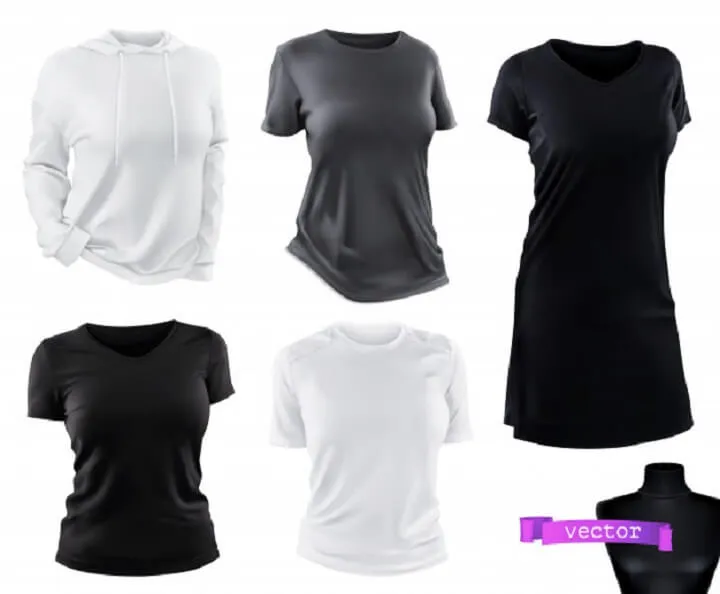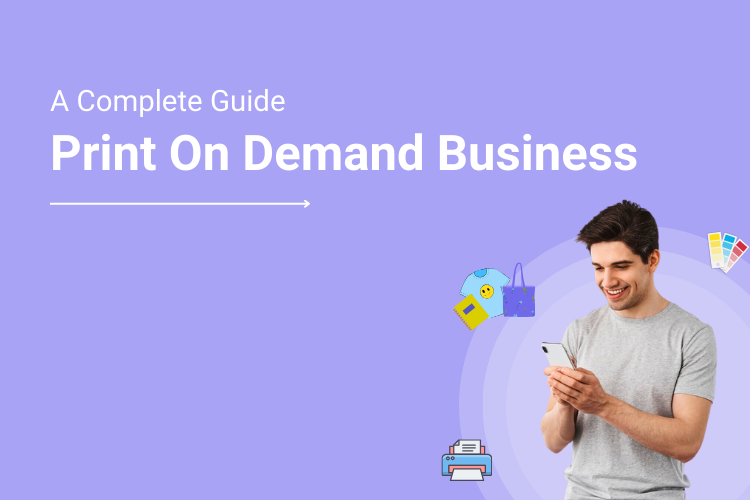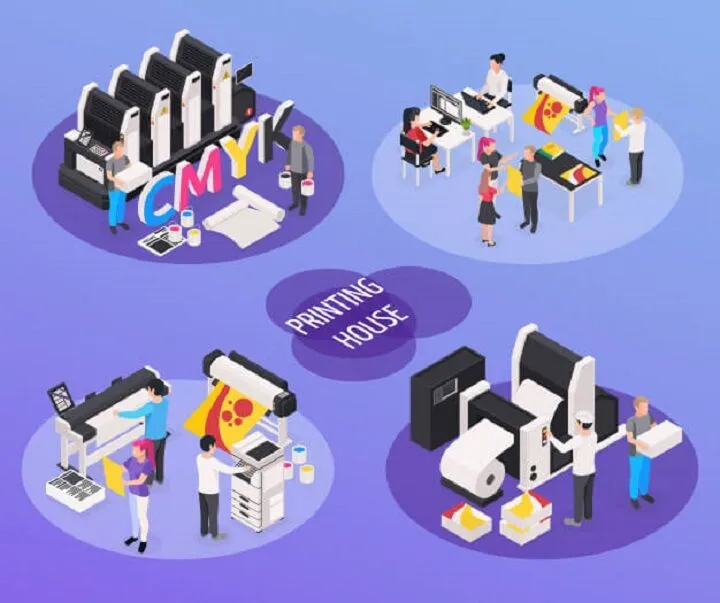When India-based online travel website MakeMyTrip launched an online gourmet delivery service early May 2020, it was clear that the new norm is pivoting to supply essential food and beverage requirements during the pandemic.
Businesses are increasingly adopting personalization into products and services to market themselves and improve sales in these uncertain times. For eCommerce stores, especially, on-demand printing is a great way to increase conversions.
What is Print On Demand (POD)
You can think of POD as a type of drop-shipping business model in which the merchant is not in charge of the inventory management and shipping. That means when you sign up with a POD platform, they take care of everything for you. Let us understand this in detail.
For example, your eCommerce store sells customization print products such as t-shirts or coffee mugs. In the POD business model, there is no physical inventory. Although consumers can customize these products and place an order on them, you will never handle inventory management, shipping, and fulfillment.
Before delving any further into what POD has to offer, it is crucial to understand the distinction between POD fulfillment services and POD marketplaces.
Print-On-Demand: Fulfillment Services vs. Marketplace
These are Print-On-Demand services that enable your eCommerce printing business to connect to the POD platform as a back-end service. This way, when a consumer purchases a product from your website, the order is sent to the POD service provider for printing and fulfillment. These service providers act as your POD fulfillment partners.
This takes care of both the front-end and back-end aspects of the process. The artwork and designs will be given the license to be used on physical products and sold on the marketplace. The POD marketplace will handle the marketing and selling of your products.
Which One to Choose?
Depending on your eCommerce business objectives and your personal preferences, you can choose to opt for either of the two POD services. While fulfillment services give you more control of your products and the brand, marketplaces are also ideal, especially if you are an individual business owner and want to sell a range of printable products.
However, it is essential to know that the former option entails more work because it requires you to have your customer-facing storefront. On the contrary, marketplaces give you an easy choice to market and sell your products by allowing someone else to handle it.
Starting a print on demand business in 10 simple steps
1. Research and Identify Your Niche:
Identify your print-on-demand products’ target audience and niche market. Research trends and demographics to find a lucrative niche that matches your interests.
2. Choose a Print-On-Demand Platform:
Select a reliable print-on-demand platform that suits your needs. Some popular options include Printful, Printify, and Gooten. Consider factors such as product range, pricing, quality, integration options, and customer support.
3. Create Designs or Source Artwork:
Develop your own unique designs or collaborate with talented designers to create artwork for your products. Ensure your designs are original, visually appealing, and relevant to your target audience.
4. Set Up Your Online Store:
Create an online store using an e-commerce platform like Shopify, WooCommerce, or Etsy. Customize your store’s design, layout, and branding to reflect your unique style and attract customers.
5. Integrate Print-On-Demand Platform
Connect your chosen print-on-demand platform with your online store. This integration will enable seamless order processing, production, and fulfillment of your print-on-demand products.
6. Choose and Customize Products:
Select the products you want to offer, such as t-shirts, hoodies, mugs, or phone cases. Use the print-on-demand platform to customize product options, including colors, sizes, and designs.
7. Set Competitive Pricing:
Determine your pricing strategy by considering your production costs, platform fees, shipping expenses, and desired profit margin. Research the market to ensure your prices are competitive while still providing value to customers.
8. Promote Your Store:
Develop a marketing plan to promote your print-on-demand business. Utilize social media platforms, email marketing, influencer collaborations, and content marketing to raise awareness and drive traffic to your online store.
9. Provide Excellent Customer Service:
Prioritize customer satisfaction by promptly addressing inquiries, providing accurate product information, and ensuring timely order fulfillment. Positive reviews and customer referrals are vital for the success of your business.
10. Analyze and Adapt:
Regularly analyze your sales data, customer feedback, and market trends. Adjust your product offerings, marketing strategies, and designs based on insights to optimize your print-on-demand business.
Let us now understand in detail how the POD process works.
1. Store setup
The first step of the process is to set up your POD store. Depending on your POD platform, you can set up your store in two ways:
- Integrate your existing printing website to the POD service and start selling from there.
- Use a POD marketplace. If you don’t have your eCommerce website or printing storefront, you can opt for a POD service with an existing marketplace to market and sell your products
2. Products and designs
Once you have set up your POD eCommerce storefront, the next and most essential step in the process is to select designs and add products to the store. As a business owner, you can decide what you want to sell based on popularity and market trends.
For example, if you wish to sell posters and wall art, you can add framed canvas products to your eCommerce store. Most product design tools come with extensive photos, font, and vector libraries.
3. Sales
In the third step of the process, you need to create awareness and engagement for your printing business to boost sales. If you are using a fulfillment service, then you need to market aggressively to attract customers. However, if you are using a POD marketplace, then your offerings will be sold for you.
4. POD platform
The Print On-demand platform takes care of the printing, fulfillment, and order shipping processes once a consumer places an order. You will be paid for the order once their purchase has been cleared.
Pros and cons of a Print-On-Demand platform for printers
A. Pros
Easy to setup: POD platforms are straightforward to set up and configure. You only need to register, create an account, and add your designs and products.
No inventory management: One of the challenges inventory-based eCommerce business owners have to deal with regularly is to manage inventory and stock costs. With a POD platform, products are printed only after a purchase is made. This is beneficial because you won’t be left with merchandise that doesn’t get sold.
End-to-end fulfillment: A POD platform takes care of all the processes, including order fulfillment, packaging, shipping, and delivery. This is particularly useful if you are an individual entrepreneur or a small business owner.
Focus on the creative aspect of the business: : Web-to-print solutions enable you to focus on the business strategy and creative elements rather than being occupied with mundane processes such as quotation, packaging, shipping, and more.
B. Cons
Reduced profit margins: Perhaps one of the major setbacks in the POD business model for an online printer is that the profit margins are considerably lower. This is also because when you buy from an on-demand printing service, the product’s cost is higher than that of a product bought in wholesale purchases.
No interaction with the customer: Because the POD service provider is solely in control of the entire order fulfillment process, you do not have the liberty to be a part of the packaging and shipping processes. This means that you cannot add any personal touches to your product, or have an interaction of any kind with your customer.
Limited data access: If you are an eCommerce owner who relies on purchase history and customer data to make business decisions, then POD is probably not the best option because that data is limited to the service provider only.
Smaller product range: The type of products you want to sell depends on your POD service provider. For instance, if your business sells a niche product (such as custom uniforms) that is not easily available in the market, finding a POD platform that would help you sell your product would be challenging.
Let us take a look at some of the popular Print-On-Demand products in the market:
1. Custom Apparel
T-shirts, shorts, skirts, hoodies, leggings, scarves

2. Wallpaper art
Posters, banners, wall decals, framed artwork, tapestries, and canvas prints

3. Accessories
Bags, belts, jewelry, hats, socks, visors, caps

4. Home Accessories
Coffee mugs, beverage glasses, bedspreads, pillow covers, towels, table matsTech accessories – smartphone covers and cases, pop sockets

Now that we have a better understanding of the Print-On-Demand business model and its advantages and disadvantages, let us see how you can start a POD eCommerce business.
The next section discusses some useful tips to keep in mind:
1. Choosing the right POD platform or service provider
As an eCommerce business, your primary goal is to be able to sell your products in the marketplace while ensuring that your customers are satisfied. That is why it is essential to choose a POD platform that works well with your business objectives.
Here are some key points you should take note of:
- Integration of the POD platform with your existing systems
- Merchant policies – Be sure to take a look at the seller policies of the POD platform. Do they match your expectations and requirements?
- Order fulfillment processes – How does the POD service provider take care of fulfillment services such as creating, packaging, shipping, and delivery?
- Subscription costs of the POD platform
- Product types – What type of products is the POD service selling to customers? Does it match with the product type you wish to sell?
2. Order samples from a few POD service providers
Considering you have shortlisted a few online product designers for your business, it would be helpful to order some samples from each POC service provider to get a better understanding of their business processes. Moreover, it is critical to know how they carry out their services because you will be giving a part of your business to the POD platform.
3. Create product mock-ups
It would be useful to create high-quality mock-ups for your products once you have an idea of how to go about this process. Product mock-ups allow you and your customers to visualize how the product looks when a design is added.
This will give you an idea of how your product should look and if there are any changes to be made to the same. Hence, test the product designer software in question, and then take a call.
4. Decide on a pricing strategy
Like any business, the ultimate aim should be to drive profits. A healthy profit margin, according to market standards, stands at 40%. Although it depends on you to decide the margin of profit for your products, you can also make use of a profit margin calculator to determine how to price your products.
5. Leading POD players in the market for printers
Significant players currently doing a fabulous job offering the POD service include Shopify, JetPrint, T-Pop, Teelaunch, Printful, and SPOD, among others. If you are looking for a web-to-print solutions provider to sort out the basics, then Design’N’Buy tops the list.
Start a successful POD business with DesignNBuy
Finally, remember that your business’s success depends on your print designs and artwork, as well as the POD fulfillment partner you choose for your business.
FAQs
Do I need design skills to start a print-on-demand business?
While design skills can be beneficial, you don’t necessarily need them. You can collaborate with designers or use design marketplaces to source artwork for your products. Some platforms also offer design tools to create simple designs.
How do I integrate a print-on-demand platform with my online store?
Integrating a print-on-demand platform with your online store usually involves installing a web-to-print plugin provided by the platform. The integration allows for seamless order processing, production, and fulfillment of your print-on-demand products.
How do I market my print-on-demand business?
To market your print-on-demand business, utilize social media platforms, email marketing, influencer collaborations, and content marketing. Engage with your target audience, showcase your products through appealing visuals, and leverage digital advertising to reach potential customers.
What are the potential challenges of running a print-on-demand business?
Challenges may include intense competition, maintaining consistent product quality, managing customer expectations, and keeping up with evolving market trends. It’s important to stay adaptable, innovative, and focused on delivering value to your customers.





